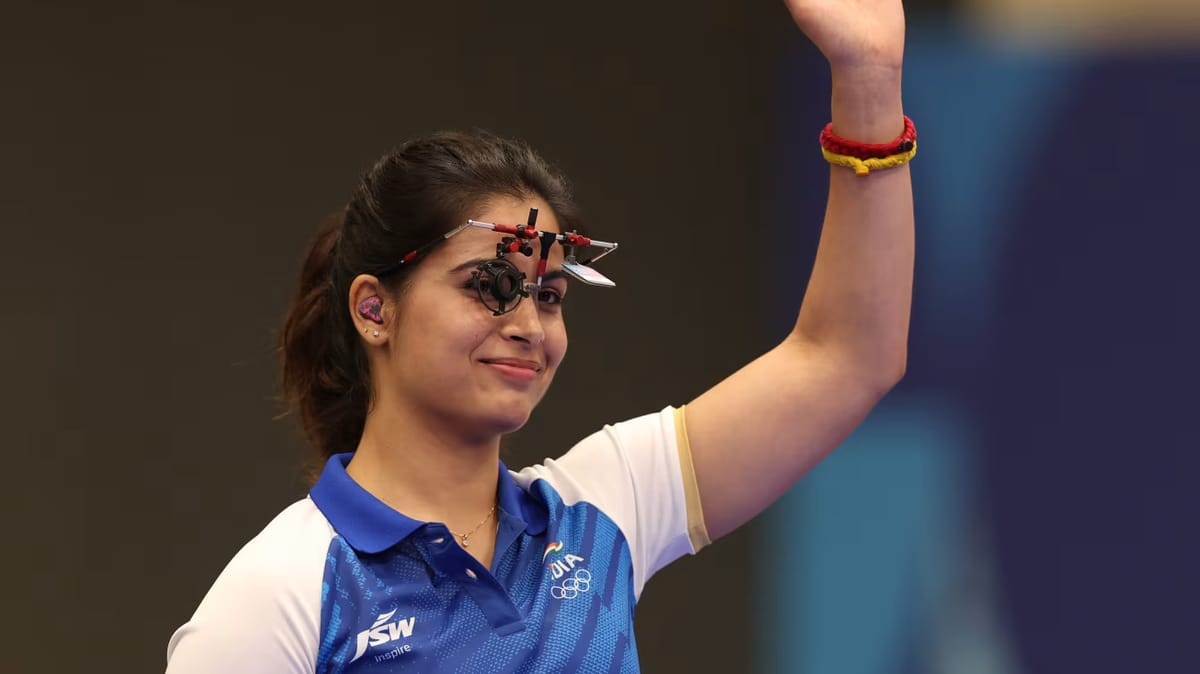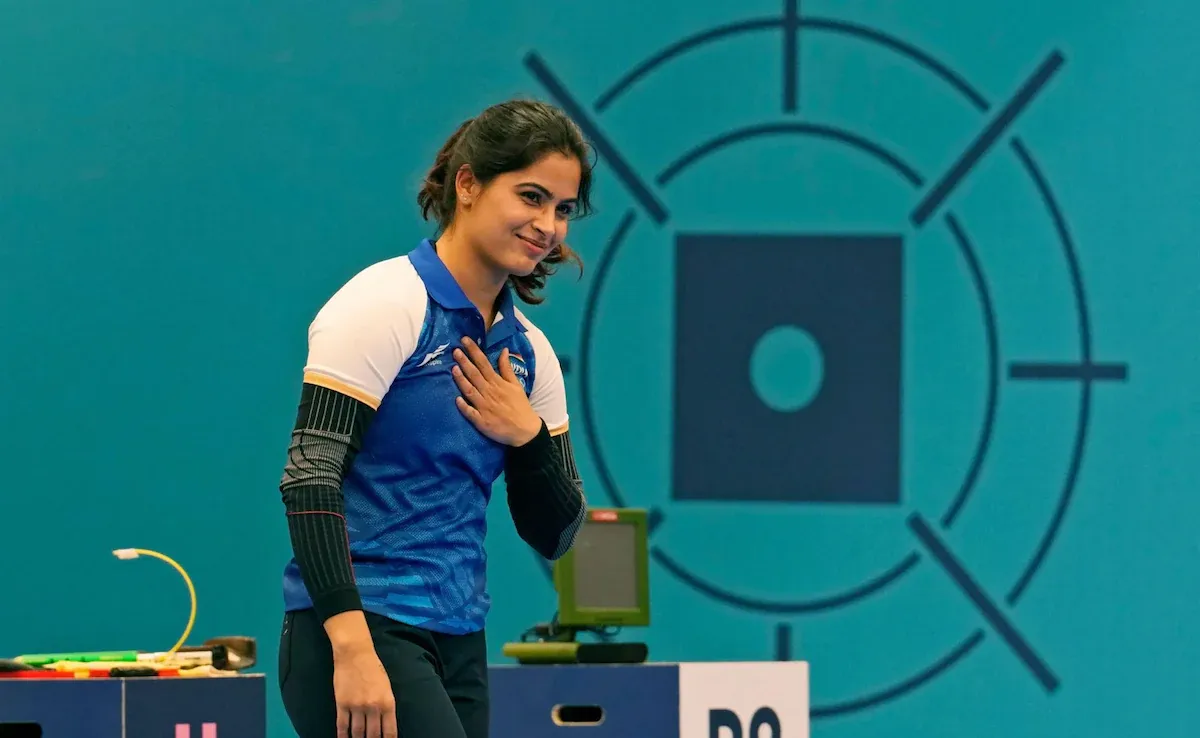India’s Junior Women Make History: The 25m Pistol Gold Rush at Asian Shooting Championship 2025
In a historic display of dominance at the Asian Shooting Championship 2025 in Shymkent, India’s junior women swept the 25m pistol podium.

Written by Lavanya, Intern, Allegedly The News
SHYMKENT, KAZAKHSTAN, August 26, 2025
A seismic shift has occurred in the world of international shooting, and its epicenter is Shymkent, Kazakhstan. At the 16th Asian Shooting Championship, the Indian contingent, led by an extraordinary performance from its junior women, delivered a statement of intent that will resonate far beyond the shooting range. While the nation’s senior athletes consistently contributed to a formidable medal tally, it was the unprecedented clean sweep of the junior women’s 25m pistol event that truly marked a new era. This is a story of a nation’s long-term investment in its athletes finally reaching a powerful, visible crescendo. It’s about more than just medals; it's about a well-oiled system, a mental revolution, and a new generation of female athletes leading the charge.
The Gold Standard: A Junior Team's Masterclass
The story of the junior women's 25m pistol final is a testament to perfect execution under pressure. On a day filled with high stakes and intense competition, the three young Indian shooters, Payal Khatri, Naamya Kapoor, and Tejaswani, executed a flawless strategy. They didn't just win; they dominated. The trio claimed all three podium spots - gold, silver, and bronze, an achievement so rare and significant it immediately etched their names into the annals of Indian sporting history.
The final results were a clear reflection of their superiority:
- Payal Khatri: Gold 🥇 (36 points)
- Naamya Kapoor: Silver 🥈 (30 points)
- Tejaswani: Bronze 🥉 (27 points)
This trio also combined to secure the team silver with a total of 1700 points, finishing just behind the formidable Korean team. This historic sweep is a direct result of the National Rifle Association of India (NRAI)'s long-term vision to build a deep, sustainable talent pipeline. Gone are the days when Indian shooting relied on one or two star players. Today, there is a fierce and healthy competition among a pool of highly-trained athletes, ensuring that excellence is not an anomaly but a standard.
Payal Khatri, who entered the final in sixth place, showcased nerves of steel and a stunning comeback to clinch the gold. Her performance is a textbook example of how a shooter's mental fortitude can be the decisive factor. Naamya Kapoor's consistency was rewarded with a well-deserved silver, while Tejaswani’s bronze completed the magical podium sweep, a moment that will be celebrated for years to come.
The Veteran’s Perspective: Manu Bhaker's Strategic Fourth Place
While the junior’s victory captured the headlines, the performance of India's seasoned campaigner, two-time Olympic medallist Manu Bhaker, provides a crucial layer of insight. Bhaker, at just 23, is already a veteran of the sport, and her fourth-place finish in the senior women's 25m pistol event is far from a failure. In fact, it is a valuable data point in her journey toward Olympic glory.
Finishing with 25 points, just four points behind the bronze medallist, Bhaker’s performance came against a field of the world's best, including a dominant Chinese duo who battled each other in a shoot-off for the gold. Bhaker’s run to the final and her subsequent fourth-place finish provide her coaching team with invaluable information regarding her performance under pressure, especially in the rapid-fire stages of the final.
Her experience at this championship is a microcosm of the challenges faced by elite athletes. Every international competition is a rehearsal for the Olympics. A close call like this serves as a wake-up call and a diagnostic tool, highlighting areas for improvement without the ultimate disappointment of a major final loss. It allows her to refine her technique and mental game, ensuring she is at her peak when it matters most. Bhaker's journey and her ability to bounce back from near-misses are crucial lessons for the younger generation. Her experience underscores that a champion's path is not just a straight line to the podium but a continuous process of learning and adaptation.

The Grand Design: How Asian Championships Fuel Olympic Dreams
The Asian Shooting Championship is not merely a regional competition; it is a vital part of the global sports ecosystem. For athletes, these events are crucial for two main reasons: qualification and preparation.
Qualification: While Olympic quota places are no longer on offer at the 2025 Asian Championship, performances here directly influence world rankings and open up opportunities for future qualification events. A strong showing boosts an athlete's profile and increases their chances of securing a quota place down the line.
Preparation: The true value of an event like this lies in its role as a pressure-cooker environment. The best of Asia, including perennial powerhouses like China, Korea, and Japan, converge here, offering a competitive field that mirrors an Olympic-level challenge. For young talents like Payal, Naamya, and Tejaswani, competing against the best in Asia is the ultimate litmus test before they step onto the world stage. It's a rite of passage that builds confidence and experience. For established stars like Bhaker, it’s about fine-tuning her skills and getting accustomed to the competitive rhythm.
The championship also highlights the efficacy of the coaching and support systems in place. India's ability to consistently produce top-tier shooters across different disciplines and age groups is a testament to the structured training, scientific approach, and strategic investment being made by the NRAI and the government.
The Looming Battle: India vs. The Shooting Giants
For decades, international shooting has been a story of Chinese and Korean dominance. China, in particular, has a history of churning out Olympic champions with a state-sponsored system that identifies and nurtures talent from a young age. South Korea’s precision and discipline have also made it a formidable force. At this championship, China once again demonstrated its strength, sweeping the gold and silver in the senior women’s 25m pistol.
However, India's performance at the 2025 Asian Championship suggests a fundamental shift in this power dynamic. The overall medal tally for India, a staggering 41 medals, including 23 gold, 8 silver, and 10 bronze, places them at the top of the leaderboard, surpassing even China’s formidable haul. This is not a fluke; it's a trend. India’s success in both junior and senior categories, across different events like air rifle, pistol, and trap, indicates a comprehensive and systemic rise. The victories are not confined to one discipline or a single superstar. From Aishwary Pratap Singh Tomar's gold in the men’s 50m rifle 3P to the mixed team golds in 10m air rifle, India is demonstrating an unprecedented depth of talent.
The junior women's 25m pistol sweep is a powerful symbol of this new reality. It proves that India is no longer just chasing the giants; it is now standing shoulder-to-shoulder with them, and in some categories, even leaving them behind. This is a clear warning to China and Korea that they are no longer the undisputed kings of Asian shooting.
A Celebration of Women: Reshaping the Sports Narrative
The most compelling aspect of India's success at this championship is the role of its female athletes. From the junior sweep to the individual and team medals won by senior shooters, Indian women are at the forefront of this shooting revolution. Their success is a powerful narrative of empowerment and national pride. It challenges traditional gender roles and inspires millions of young girls across India to pursue their athletic dreams.
The women are not just participating; they are leading. Their relentless pursuit of excellence, often against immense societal pressure and expectations, is a story that goes beyond the shooting range. Their victories are a validation of their dedication, the support systems in place, and the changing mindset of a nation that is embracing its female athletes as true heroes.
Analysis of Challenges and the Path Forward
While the current success is a cause for celebration, the road ahead is fraught with challenges. Sustaining top-tier performance requires continuous innovation and adaptation. The experience of Manu Bhaker highlights the psychological demands of elite sports. The pressure to constantly perform at the highest level can be immense, and a single bad day can be dissected endlessly. India's shooting ecosystem must now evolve to include comprehensive mental conditioning and sports psychology programs to support its athletes.
Furthermore, maintaining the depth of talent requires a continuous feedback loop between junior and senior levels. The NRAI must ensure that the transition for young champions is smooth, providing them with the necessary international exposure and specialized coaching to compete at the senior level. The rise of a new wave of talent also creates new challenges, such as managing expectations and providing equal opportunities to all deserving athletes.

The New Dawn
The 2025 Asian Shooting Championship was more than just a competition; it was a powerful declaration. India is no longer an emerging force in shooting; it is a dominant one. The junior women's 25m pistol clean sweep is the most compelling evidence of this transformation. It signifies a tipping point where years of strategic investment, grassroots development, and the indomitable spirit of its athletes have converged to create a sustained winning culture. The medal tally and the nature of the victories—coming from both seasoned veterans and a new generation of champions—paint a picture of a nation ready to challenge the best in the world. The future of Indian shooting is not just bright; it is a blazing beacon, and its light is being cast by its unstoppable women.
Beyond the Bullseye: How Do We Secure India’s Legacy?
The immediate success is clear, but what is the next step to ensure this is not a flash in the pan? How can India continue to build on this momentum?
- What specific, long-term investments in sports science, psychological support, and coaching can be implemented to ensure the sustained dominance of Indian shooters for the next decade?
- How can we, as a nation, better celebrate and support the mental and physical well-being of our elite athletes, moving beyond the binary of victory and defeat?
Sources
Information for this report was compiled from official results and news reports from the Asian Shooting Championship 2025 in Shymkent, Kazakhstan, along with historical data on international shooting competitions.




